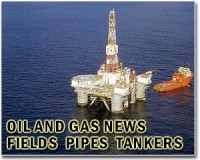 |
New Orleans, Louisiana (AFP) July 22, 2010 A storm threatened on Thursday to force the evacuation of the drilling rigs that are the final solution to a three-month environmental and economic nightmare in the Gulf of Mexico. Skimming vessels were ordered to port ahead of top US official Admiral Thad Allen's crucial decision on the rigs, which could see the end-stage operation to plug BP's runaway well delayed from mid-August into September. The good news for those in the Gulf region struggling to cope with the aftermath of perhaps the biggest ever accidental oil spill was that the cap that has been holding back the torrent of crude for a week can stay on. "Based on the recommendations of Doctor Steven Chu, the Secretary of Energy, and the science team, we have determined that if we have to evacuate the site we are prepared to leave the well capped," Allen said. There had been fears the cap would have to be opened up or even removed because nobody would be on site to monitor any pressure anomalies in the well or oil seepage on the sea floor. But Allen said that whatever his decision -- expected around 0100 GMT Friday -- he hoped some vessels would remain on site to run the underwater submarines doing the monitoring. If the depression, expected to become Tropical Storm Bonnie later Thursday, barrels towards Louisiana as expected it will delay a so-called "static kill" to seal the well with cement originally planned for this weekend. Allen said the latest forecast showed the storm hitting the area on Saturday morning and passing by some 24 hours later, whipping up high seas that could force vessels including the drilling rigs to be evacuated. "During that time it is very possible that we will have wave heights that would exceed the operation envelope for all platforms," he said. The storm forced work to be suspended on the casing of the relief well -- which should intercept the damaged well and allow it to be permanently filled in with cement -- to allow a special cap to be inserted to stabilize it. Once the casing has been finished and fixed in place with cement, which takes up to seven days, officials hope to perform a "static kill" to plug the well by injecting heavy drilling mud and cement through the cap at the top. The final operation to cement the reservoir once and for all through the relief well would be expected five to seven days after that. "Obviously that entire process now will be offset by whatever days we lose if we have to detach and move off scene," said Allen, who along with other officials has talked of a 10-12 day delay. A full-scale evacuation would be a huge blow for local residents who already see efforts to choke off the well as too little too late, with hundreds of miles of coastline already fouled. The five US states along the Gulf of Mexico could lose 22.7 billion dollars in tourist revenue over the next three years because of the spill, a study showed Thursday. A vast swath of the Gulf has also been closed to commercial and sport fishing since the BP-leased Deepwater Horizon rig sank on April 22, two days after an explosion that killed 11 workers. But US officials reopened Thursday one third of those fishing grounds after no oil was seen in the area for 30 days and tests revealed the fish there were not being polluted. Oil industry jobs in the region were also hit by President Barack Obama's decision to impose a moratorium on new deepsea drilling -- a move fiercely opposed by local leaders. If an upper estimate of over four million barrels is confirmed, what is considered one of America's worst ever environmental disasters would also be the biggest accidental oil spill ever. After three frustrating months marked by several botched attempts to contain the leak, BP finally sealed the well with its new cap last Thursday and no significant amount of oil has entered the sea since. Four of the world's oil giants said Wednesday they hoped to capitalize on the lessons learned by joining forces to create a similar system to BP's present one in case of another catastrophic spill. Exxon Mobil, Chevron, ConocoPhillips and Royal Dutch Shell announced they would each contribute 250 million dollars to create a non-profit group, the Marine Well Containment Company. The new venture would design, build and operate a flexible system that could mobilize within 24 hours to siphon and contain 100,000 barrels of oil per day in depths of up to 10,000 feet (3,000 meters), the companies said.
Share This Article With Planet Earth
Related Links Powering The World in the 21st Century at Energy-Daily.com
 Faced with oil spill, Gulf residents fight mental pain
Faced with oil spill, Gulf residents fight mental painBuras, Louisiana (AFP) July 21, 2010 With the Gulf oil spill destroying livelihoods across southern Louisiana, anxiety over an uncertain future is prompting a desperate rise in depression, health officials and residents warn. "This whole area is gonna die," cried fifth-generation fisherwoman Darla Brooks in an interview Wednesday with AFP, in the small fishing-based town of Buras. "Down here, we have oil and we have fishing ... read more |
|
| The content herein, unless otherwise known to be public domain, are Copyright 1995-2010 - SpaceDaily. AFP and UPI Wire Stories are copyright Agence France-Presse and United Press International. ESA Portal Reports are copyright European Space Agency. All NASA sourced material is public domain. Additional copyrights may apply in whole or part to other bona fide parties. Advertising does not imply endorsement,agreement or approval of any opinions, statements or information provided by SpaceDaily on any Web page published or hosted by SpaceDaily. Privacy Statement |